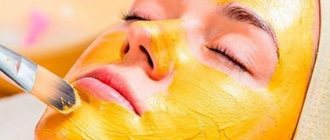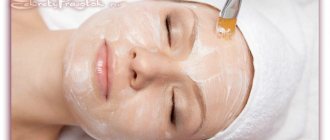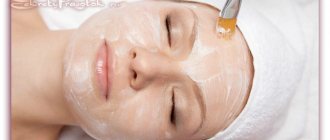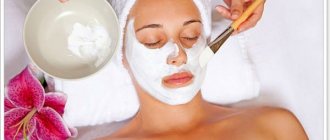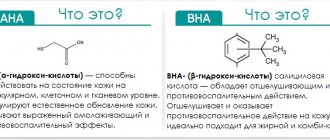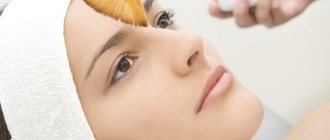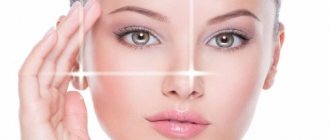Chemical facial cleansing using retinoic acid is gaining increasing popularity: it is effective with minimal recovery time. You can carry out retinoic peeling at home, but in this case you need to pay special attention to the drugs: both the order of application and the final result will depend on them.
What is it - yellow (retinoic) facial peeling
What is retinoic peeling? This is a method of applying a special product to the skin to cleanse, restore and provide necessary nutrients. The mixture contains retinoic acid, which is an analogue of vitamin A, as well as auxiliary agents: azelaic, phytic, kojic and ascorbic acids.
This cosmetic method is a type of chemical peeling, but differs significantly from them. Thanks to the harmonious combination of active ingredients, the main effect occurs on the middle layer of the epidermis. After all, it is he who ensures the regeneration and restoration of cells. In addition, collagen synthesis is activated and microcirculation improves. The surface layer of the epidermis is cleansed from dirt and impurities.
Features of the effects of chemical peeling on the skin
Retinoic peeling has virtually no contraindications. It can be used even by people who have extremely sensitive and thin skin. Under the influence of retinol, reduction-oxidation and metabolic processes in the epidermis are activated, cell division is initiated, and the production of collagen and elastin is stimulated.
The epidermis becomes more elastic and resilient, its hydrolipid mantle is restored, and a lifting effect occurs. Provides intense hydration to all layers of the skin, eliminating dryness and flaking. Getting rid of pigmentation is one of the main effects that occurs after using this cosmetic product. This is due to its unique whitening properties. As a result, the skin becomes smooth, healthy and youthful. You can find out about deep facial peeling here.
In addition, peeling with retinoic acid actively removes dead skin cells from the surface layer of the skin, successfully eliminating keratomas and signs of photoaging. Supports the protective functions of the epidermis, activates its ability to resist various viruses and bacteria, restores the immune properties of the surface layer of the skin, and has an anti-inflammatory effect.
Vascular formations disappear, pores narrow, and the appearance of acne decreases. An additional advantage of yellow peeling is that it has an oncoprotective effect.
Indications and contraindications for use
What is yellow peeling and when should it be done? Regular facial and body skin care will ensure a healthy and radiant appearance. However, over time, the natural processes of aging begin to prevail over the effects of cosmetics. The first signs of aging appear as early as 25 years of age, but for people who regularly take care of their skin, this may be completely unnoticeable. For others, on the contrary, the first signs of skin aging appear more and more every year. You can find out about peeling at home with calcium chloride here.
The video explains what yellow peeling is:
Indications:
- age-related skin changes in the form of photoaging;
- insufficient collagen production;
- dry skin, the appearance of fine wrinkles;
- withering, decreased firmness and elasticity;
- hyperpigmentation;
- hyperkeratosis;
- acne, post-acne.
Despite the fact that retinoic peeling provides a gentle effect on the epidermis, there are certain contraindications to its use. First of all, this is the period of pregnancy and breastfeeding. The presence of allergic reactions to one of the components used during peeling. Exacerbation of herpes virus infection. Fungal and infectious-inflammatory diseases of the skin in the affected area, as well as cuts, abrasions and other damage to the integrity of the skin. Contraindications include the presence of severe diseases of internal organs in the stage of subcompensation and decompensation, as well as taking medications that contain vitamin A.
Indications for use
With retinoic peeling, the effect is on the outer tissues of the epidermis. The procedure can be carried out in a beauty salon or at home.
Retinoic peeling, which softens and cleanses the skin, making it more youthful and elastic, is also called yellow peeling.
Expert opinion
Elena Apostolyuk
Cosmetologist
The main component in its composition is retinoic acid, which has a yellow color and is a synthetic analogue of vitamin A (retinol). This substance promotes active exfoliation and renewal of the skin, due to which the aging process is inhibited and wrinkles do not deepen so quickly.
Retinoic acid accounts for 30% of the peeling preparation; additional components are selected individually, taking into account the type and condition of the skin.
Yellow peeling is recommended at home for the following problems:
- comedones with different contents;
- purulent inflammatory formations;
- excessive pigmentation;
- excessive secretion of sebaceous glands;
- scars, post-acne;
- rapid processes of skin aging, the appearance of sagging, stretchiness;
- first age wrinkles.
As a cleansing and anti-aging agent, retinoic peeling is recommended for women over 35 years of age who have already begun to notice age-related skin changes. The procedure is especially useful if fine-wrinkled aging is noted.
Retinol peeling - indications and contraindications: features
Retinol peeling - indications
Retinol peeling is an effective procedure that allows you to:
- Remove freckles and age-related pigmentation
- Rejuvenate skin and slow down its aging
- Get rid of skin unevenness and wrinkles
- Improve blood circulation
- Restore immunity and improve skin health
- Get rid of acne and other problems
Retinol peeling has many indications for:
Skin aging
Such peeling should be carried out when there are even slight changes in the skin, manifested in the appearance of skin folds and small wrinkles. The effect of retinoic acid can reduce already visible wrinkles, improve the appearance of the skin and make it elastic.
Thickening of the stratum corneum or scarring
After peeling, the skin becomes thinner, but at the same time it is still healthier. If you have the first symptoms of keratinization, they will disappear.
Problem skin
Yellow facial peeling
Cosmetologists claim that the procedure is highly effective, especially in terms of getting rid of pimples and blackheads. Retinoids stimulate cells to fight off infection. This allows the skin to recover from inflammation. Moreover, retinoic peeling helps reduce skin oiliness and fights acne and blackheads.
Hyperpigmentation
The procedure allows you to whiten the skin and eliminate age spots.
It is important to say that all procedures that involve the use of acid have contraindications. They need to be clarified in advance so that there are no problems later
Thus, the procedure is prohibited in the following cases:
- Pregnancy and breastfeeding
- Presence of small wounds on the skin
- Allergic reaction to the components of the drug and vitamin C
- Inflammations on the skin
- Prolonged exposure to the sun - solarium or tanning
- Herpes or papillomas
- Recent antibiotic use
- Somatic diseases, for example, the respiratory system
- For a disease that affects the skin by a microscopic mite. It's called demodicosis
- If your wounds are healing slowly
Retinol peeling - side effects: list
Retinol peeling - side effects
Peeling is a fairly deep procedure that forces you to get rid of the top layer of skin. Accordingly, some complications may arise after it. Some turn out to be quite predictable. And some turn out to be very unexpected. They appear within two weeks and can be expressed to varying degrees.
- Erythema
This is a reddening of the skin that can last differently for everyone. For example, if alpha hydroxy acids were used for the procedure, the redness may last only a few hours. Sometimes redness persists longer, up to several days. If a medium TCA peel was used, the erythema can last even 5 days. There are also longer periods, up to one year.
- Peeling skin
Many people are familiar with this, and peeling itself involves peeling. Usually after the procedure this phenomenon goes away after several days. After a mild peeling, it is almost invisible, but strong chemicals give a very clear result.
It is clear that this does not look like the best way, but it is better not to remove anything manually, as there is a risk of damaging the skin. The whole process should be natural. Your task is simply to moisturize your skin on time.
- Swelling
Swelling after peeling
Swelling is a consequence of capillary permeability after the procedure. More moisture penetrates through them than usual and therefore swelling appears.
When peeling is done with fruit acid, swelling practically does not appear. But they appear with a stronger effect, which is retinol peeling. The first swelling occurs after a few days, and it persists for some time. That is why specialists carefully select a composition suitable for the skin to reduce manifestations.
- Darkening of the skin
This can also happen, but there is nothing to worry about because it will go away once the exfoliation is complete.
- Increased sensitivity
After peeling, the skin is always more irritated. The problem goes away on its own, but can become a real problem if it lasts for a very long time.
All the complications described above are predictable and occur in most girls. However, there are also those that can be unpredictable. It's all individual. Such manifestations spoil the entire appearance of the face, and can also threaten health and therefore need to be treated urgently.
- Infection caused by herpes
It usually appears when herpes is already present in the body, but it is at the stage of relapse. Although there are cases of primary infection when the immune system is not able to cope with the virus. In this case, the doctor prescribes the correct treatment and serious consequences can be avoided.
- Allergy
Yellow peeling
After peeling, the skin loses its protection for some time, and therefore an allergy can be triggered even by something that you previously perceived as normal. To prevent this from happening, it is better to test in advance for allergens and components of the drug for the procedure. The complication is treated with the help of special medications.
- Skin marbling
This problem occurs when too many melanocytes die. The peeling procedure is especially risky for those with dark skin. It is almost impossible to correct this situation. All you can do is do a few more peeling sessions to even out your skin tone.
- Persistent erythema
This complication can occur when superficial vessels dilate. The reaction lasts up to one year, but often it goes away on its own. To make rehabilitation faster, try to avoid harmful factors - frost, heat, and so on.
- Hyperpigmentation
This can only occur if the specialist made an incorrect diagnosis before the procedure. So, if the places where melanin is produced especially strongly are treated incorrectly, this will lead to the appearance of dark spots.
To avoid such a problem, contact only professional salons where cosmetologists can be trusted. If the problem manifests itself, then it can be eliminated with the help of mesotherapy.
- Seborrhea and acne
It can occur when the cells responsible for sebum become inflamed. The greatest risk is observed in patients who have chronic seborrhea or excessively oily skin.
To prevent the inflammatory process, you can drink a complex of vitamins. If a side effect still appears, then a course of antibiotics is prescribed.
- Dermacation line
To put it simply, this line appears in the place between the treated and untouched areas of the skin. Since the peeling procedure whitens the skin, after the procedure it will be noticeably lighter than in the area without treatment. For people with fair skin this is not critical, but on dark skin it will definitely be noticeable. This problem can be solved by Jessner peeling, but it cannot be done right away. You need to wait a while.
How is yellow retinol peel done?
The retinol peeling procedure does not require any special preparation of the skin. The recipe is simple: retinol is applied to the face for 7-8 hours. After this, the product must be rinsed off with warm water. The person does not experience any discomfort (especially painful), except for the fact that he wears a yellow mask for half a day. Five days after the procedure, the exfoliation process begins, which lasts three days.
To speed up the healing process and enhance the desired effect, it is imperative to use professional cosmetics. As for the time spent on the entire process and the required number of procedures, it all depends on the individual characteristics of your body. In many cases, one procedure will be enough, but for the best result you need to do this peeling three times with a month between procedures.
How to make yellow peeling
The procedure for retinol peeling at home: features, instructions
How is yellow peeling performed?
Retinol peeling does not have to be done in a beauty salon. You can do this procedure yourself. It is important to simply know all the features and follow the instructions exactly. Thus, retinol peeling is carried out in several stages.
- Preparation
If you really like going to saunas, solariums, etc., then you should avoid them a couple of weeks before the procedure. Also, stop using any exfoliating products. Start using creams that contain glycolic acid. This is required to soften already keratinized skin in advance.
The necessary substances for the procedure can be found in pharmacies. A very popular remedy is Differin, Tretinoin and others.
- Application
First, clean your face very well. After this, you can apply glycolic acid, which will soften the skin and prepare it for the procedure. Next, you can apply the peeling mass. You need to soak it for 45 minutes to get the maximum effect.
- Finish stage
While you have the retinoic mixture applied to your face, additionally apply a neutralizing mixture on top of it. To do this, mix salt and water in a ratio of 0.5:1. Keep this all on your face for 7-8 hours.
It is important to note that the composition may burn the skin a little. This reaction is normal and there is no need to worry about it.
When time passes, you can rinse everything off with warm water and apply a protective cream.
- Recovery
Effect of retinol peeling
Immediately after the procedure, the skin becomes very soft and smooth. The main process of removing the dead layer will begin in about 12 hours. It happens that redness appears and does not disappear. Don't be afraid, as it will go away on its own in a few days. Full recovery will be in a week.
The procedure will be most effective if carried out in a course. You can cleanse your skin once every three weeks. It is enough to carry out three procedures on your own. The next course, if necessary, can be done only after six months.
It is important to note that the exfoliation will be strong and will last for a week. At this time, do not interfere with the process. Let it be natural. You can help your skin by using moisturizing creams, thermal water or masks.
- Care
The skin after such treatment requires careful care. It is important to protect it from sunlight and help restore water balance. Before going outside, use a cream with a high SPF filter.
WHERE TO BUY DRUGS
Before and after
The consequences of peeling are conventionally divided into expected and unexpected. The expected consequences include a normal skin reaction to mechanical stress.
Unexpected consequences are negative side effects that arise as a result of the individual reaction of the body. The patient's skin condition worsens, the rehabilitation period is delayed indefinitely. In severe cases, additional treatment is required.
In addition to TCA and yellow peeling, cosmetology also includes almond peeling and glycolic peeling.
Yellow
After yellow peeling, the result is not long in coming; the rejuvenation effect comes immediately and lasts for a year. When fighting wrinkles and red spots after acne, yellow peeling is the most delicate.
In terms of effectiveness, yellow peeling is inferior to trichloroacetic peeling. However, TCA is not a peel and the recovery time after it is longer than after other types of exfoliation.
Important! TSA is a medical procedure rather than a cosmetic one.
Almond
Almond exfoliation is suitable for removing the upper layers of the epidermis, eliminating keratinized particles and acne.
Glycolic
Glycolic peeling is based on glycolic acid. This acid is suitable for all skin types and can be used from the age of 15. Glycolic peeling exfoliates the damaged layer of the epidermis and cleanses pores. The characteristics are very similar to almond peeling.
Drugs
Ready-made kits for doing retinoic cleansing yourself can be purchased in salons, professional cosmetics stores, and also ordered online.
The ingredients for making a retinoic peel are available at most pharmacies and are sold without a prescription. You will need to buy:
- application brush,
- mixing container,
- gloves,
- cotton buds.
If the skin needs an easier cleansing option, it is recommended to prepare not a retinoic, but a retinol peel according to the recipe at home. To do this, you can use Carrot's Peel from the Russian company ARCADIA. The product has a gentler effect on the skin, which makes the epidermis restoration process faster.
The kit is designed for two sessions and includes Retinol, Day and Night cream, Instructions for use.
First, the active retinol composition and cream are applied, then the mask is left for 15 minutes, the residue is blotted, but not washed off.
Carrot's Peel is a professional product that is used in salons, so it is quite difficult to purchase it for home use.
The price for the retinoic complex ranges from 85 €.
Peeling Purles LABORATORIES DE BEAUTY (France) also belongs to the category of professional products, but the kit - a retinol ampoule (4%) and a mask with an anti-aging complex - allows you to perform yellow facial peeling at home.
At the first stage, Retinol is applied, then the Mask, which should be rubbed in until completely absorbed.
Wash off after 6-8 hours.
The cost of one set is about 30 €.
You can perform retinoic peeling at home using the following recipe:
- Apply glycolic cream to cleansed skin, softening keratinized particles of the epidermis;
- Without washing off the cream, apply retinoic ointment;
- Leave the mask on for 45 minutes;
- Neutralize acids with a mixture of soda and water;
- Wash off after 6-8 hours.
After such a retinoic peeling, you must follow the same care rules as when using professional products.
Retinoic exfoliation sessions can be repeated up to 5 times with an interval of 1 month.
Composition and action
Retinoic peeling is a type of chemical peeling that contains retinolic acid. It has a rich yellow color. This feature of the acid gave the procedure a second name – yellow peeling.
Retinolic acid is a synthetic analogue of retinol. In addition to this acid, the peeling includes ascorbic, azelaic, koic, and phytic acids. Any of them gives a positive effect for facial skin, as can be seen in the photo.
In terms of healing, yellow peeling is classified as superficial, and in terms of its effect on the skin, it is classified as medium. The first factor allows you to carry out a peeling course in the summer, at a time when other rejuvenation procedures are contraindicated.
But it should be noted that after the procedure you will have to forget about relaxing on the beach for a certain time. Retinolic acid, together with the other peeling components, has a stimulating effect, causing skin cells to divide more actively, which leads to the production of elastin and collagen and an effect on the deeper layers of the skin, helping to retain moisture.
In addition to rejuvenating the skin, retinoic peeling has a disinfecting effect and destroys the harmful effects of bacteria on the skin. This property helps to combat high oily skin. Retinol peeling receives expert reviews as the best prevention against skin diseases.
Tips from cosmetologists
Cosmetologists have a negative attitude towards yellow peeling at home. Acids act aggressively; in case of erroneous manipulations, the specialist quickly finds his bearings and corrects the situation, but an inexperienced woman may become confused, which will result in severe skin injuries.
Therefore, the opinion of cosmetologists is that only superficial cleaning with retinol and weak fruit acids is suitable for doing it yourself, while retinoic and other types of intensive peeling are best done in a salon.
For clients who have decided to take independent action, experts advise how to make retinoic peeling less dangerous at home:
- conduct sessions in autumn or winter, when solar activity is not so strong;
- pause between sessions for at least 3 weeks;
- repeat the course maximum once a year;
- a month before the session and for a month after, do not use scrubs;
- Follow all post-procedure care recommendations.
Yellow facial peeling at home is a good alternative option for women who do not have the opportunity to visit a beauty salon.
The procedure is simple, if carried out correctly and following the recommendations, it is effective and harmless. Before peeling, you should contact a cosmetologist to point out contraindications and help you choose the best recipe or purchased product.
Minuses
Yellow peeling owes its effectiveness to its aggressive effects. This entails a number of disadvantages that must be taken into account before deciding to carry out the procedure:
- long preparation;
- the need for competent patient recovery;
- influence of season on efficiency;
- the likelihood of complications;
- the need for experience, without which it is almost impossible to peel the first time without problems.
Carrying out yellow peeling at home is a bold decision. Some people cannot decide to undergo the procedure even in fairly expensive salons, and there are reasons for this. But if you follow all the steps, take precautions, properly prepare and recover after the procedure, and most importantly, test for sensitivity and reaction of the skin, then all problems can be avoided.
How yellow peeling affects the skin
Many patients love yellow peeling because immediately after the procedure, the skin acquires a color like after tanning. This is followed by two days of active peeling, then a pink, fresh complexion and completely smooth skin are left. Spots, scars, post-acne, pores become less noticeable after peeling. The synthesis of collagen and elastin is activated. Small facial wrinkles disappear, the severity of deeper age wrinkles decreases.
Indications for use of yellow facial peeling
- Correction of fine and deep wrinkles.
- Prevention of age-related changes.
- Photoaging.
- Hyperpigmentation.
- Acne (possibly).
- Post-acne.
Contraindications to the use of yellow facial peeling
- Pregnancy and lactation.
- Liver failure.
- Taking systemic retinoids (isotretinoin).
- Exacerbation of Herpessymplex and other dermatoses.
- Sensitive skin.
- Tendency to hyperpigmentation.
- Inflammatory elements at the peeling site.
- Rosacea.
- External use of adapalene and other retinol derivatives to avoid hyperreaction.
- Individual intolerance to components.
Retinoic and retinol - the same thing or not
Yellow peeling is divided into 2 categories: retinoic and retinol. They are often mistaken for the same thing, which can be a serious mistake. Retinol is a somewhat simplified version that uses natural vitamin A. It is gentler and suitable for high sensitivity. However, the effectiveness of retinoic peeling is reduced. It uses the acid of the same name with artificial substitutes for vitamin A. It is more aggressive, but more effective.
When and who should use yellow peeling?
The first thing you need to pay attention to is age. Girls under 30 years of age are not recommended to resort to any type of peeling without special reasons. The skin itself is still young, and such a procedure will only ruin it. Reasons for using yellow peeling are:
- sagging, loss of elasticity;
- acne, blackheads, inflammation;
- dark spots;
- scars;
- post-acne therapy;
- violation of the fat content of the integument;
- wrinkles;
- photoaging (relevant for those who spend a lot of time in the sun).
You can cope with all these problems even at home thanks to retinoic peeling.
Contraindications
Despite their high effectiveness, there are cases when it is better to abandon such procedures. These include:
- individual intolerance to the components included in the composition;
- allergy to aspirin;
- increased body temperature;
- pregnancy (including preparation), breastfeeding;
- exacerbation of chronic diseases;
- problems with the vascular system, heart;
- liver and kidney diseases;
- dermatological diseases, except acne and similar non-aggressive manifestations;
- HIV;
- warts;
- diseases of the pulmonary system;
- oncology.
Also, you should not peel with retinoic ointment in places with fresh damage to the skin - cuts, cracks, scratches, wounds from fresh inflammation. Before starting the procedure, you must wait until the wounds heal.
What is the difference between retinol and retinoic peels?
Yellow, retinol and retinoic are often used interchangeably. There is a difference between retinoic peeling and retinol peeling, although it is not great. They are similar in compound structure.
Retinol is a true vitamin A, fat-soluble antioxidant. This substance is found in plant and animal sources. In the human body it is synthesized from beta-carotene.
It is retinol that copes with the task of restoring epithelial tissues. It is really used in the fight against acne, inflammation, and psoriasis.
This element is also used as an anti-acne remedy, slows down skin aging, removing wrinkles, fights stretch marks, accelerating collagen production. Like retinol, it is used in the fight against cancer. After using retinoic acid, you may experience dry skin and sensitivity to sunlight. As you can see, the difference between the elements of the composition is small, but it still exists. But both retinol and retinoic peeling will be beneficial to the epidermis.
How to prepare your face - pre-peeling period
Preparation for peeling begins 2-4 weeks before the intended procedure. 4 weeks will be required if your skin is too tanned, oily, or there are signs of severe hyperkeratosis. In all other cases, pre-peeling care is halved.
Necessary:
- refuse to visit the solarium, bathhouse, sauna, and do not expose the skin to excessive sun exposure;
- do not use cosmetics containing highly concentrated acids;
- regularly apply cream with glycolic acid or retinols - this will help soften the stratum corneum of the epidermis. Then, when applying the composition, maximum impact is guaranteed.
Yellow peeling at home is practically no different from the same procedure in the salon. In particular, according to the rules of preparation for manipulation.
The protocol for the procedure itself is standard:
- cleansing from makeup, dust and dirt;
- surface treatment with an active composition;
- The exposure time depends on the chosen product. Manufacturers indicate this parameter in the finished product; when using a home remedy - an average of 5-7 hours;
- removal of workers. It is suggested to either rinse with plenty of cool water or wipe with a soda solution;
- application of cream - panthenol, a special post-peeling, moisturizing, nourishing cream. When purchasing a finished product, aftercare products may be included in the kit.
Note! During exposure, discomfort may occur in the form of burning, tightening, and tingling. As a rule, the burning and tingling sensation passes quickly, and tightness is quite normal. If the discomfort is too severe, you should immediately wash off the peeling composition and lubricate the skin with panthenol.
STEP-BY-STEP INSTRUCTION
A retinoic exfoliant will have a more noticeable effect if all the rules of preparation and care after exfoliation are followed.
Before you do yellow peeling at home, it’s worth setting aside time in your schedule - the course lasts for a month, so many people prefer to cleanse while on vacation.
Preparatory stage
Two weeks before the session, you should stop using exfoliating products.
The basis of care during this period should be weakly concentrated exfoliants with glycolic acid - they soften the stratum corneum of the epidermis and enhance the effect of retinoic acid.
General application rules
- The peeling mass should be applied to a thoroughly cleansed and oil-free face.
- The session begins with the application of a solution of glycolic acid, then a product based on retinoic acid.
- The retinoic mask is kept on the face for no more than 45 minutes - the duration depends on the condition of the skin and the desired effect.
- If the goal is to combat age spots, lightly rubbing a retinoic exfoliant into individual areas using cotton swabs is acceptable.
- The area around the eyes should be avoided and acid should not come into contact with the eyes and mouth. Otherwise, rinse eyes with plenty of water and consult a doctor immediately.
Final stage
Acids must be neutralized with a mixture of one teaspoon of baking soda and a tablespoon of water. After this, the mask is left for another 7-8 hours and then washed off with warm water.
After a retinoic mask, the skin acquires a yellowish tint and seems “tight” and dry. Therefore, you need to apply a thick layer of moisturizer to your face, suitable for the specific type of epidermis.
The neutralizing composition may cause a slight tingling or burning sensation. If the sensation causes severe discomfort, you should immediately wash off all products and consult a dermatologist.
Recovery stage
After retinoic exfoliation, the skin begins to peel, redness and swelling are also possible. At this stage, you should not use scrubs or try to speed up the process: this will take even longer to heal.
During the period of active peeling, you should not use decorative cosmetics.
During this period, water balance is important for the epidermis, so it is necessary to regularly apply moisturizing cosmetics and spray your face with thermal water. Be sure to use sunscreen with SPF40+.
HOME FEATURES
When choosing a drug for such cleaning, you need to remember the significant difference between retinoic and retinolic acids. Both substances contain vitamin A, which causes the face to turn yellow, but retinoic acid is more powerful.
Before choosing a specific beauty product, you should consult with your cosmetologist - he will study the condition of the epidermis and help you choose the right product, as well as tell you how often you should carry out the procedure.
The session can be carried out using ready-made retinoic formulations sold in salons or online stores, or you can make the mixture yourself. The most popular option is products based on retinoic ointment sold in pharmacies, which has an anti-inflammatory effect and speeds up recovery.
When conducting a session at home, you need to stock up on care products for pre-peeling preparation and recovery. In salons, such care series are used by default, and you shouldn’t neglect applying them at home either: the better the skin is prepared for retinoic exfoliation, the greater the effect you can achieve.
Who is suitable for retinoic exfoliation?
Experts recommend retinoic exfoliation after the first signs of aging appear.
If the goal is to get rid of mild acne or small age spots, but the epidermis has not lost its tone and there is not even a hint of facial wrinkles on the face, you should choose more gentle options for superficial exfoliation.
Yellow peeling at home should be done to eliminate the following shortcomings:
- Acne, acne, noticeably enlarged pores;
- Expression and age wrinkles;
- Hyperpigmentation;
- Decreased tone;
- Photoaging;
- Dryness and flaking;
- Lack of elastin.
Retinoic peeling is strictly contraindicated for 6 months before pregnancy, while pregnant and breastfeeding.
We recommend: How to properly do HAND PEELING
Retinoic formulations are not suitable for those who have experienced hypervitaminosis (exceeding the normal level of vitamin A in the body) and suffer from allergies and liver diseases.
Like any other chemical peeling, retinoic exfoliation is contraindicated in case of extensive dermatological lesions in the application area, as well as during infectious diseases, including colds.
Time frames and restrictions for retinoic cleansing
Both salon and home retinoic and retinol facial peeling are recommended to be carried out during the cold season, since the sun's rays slow down the recovery process and reduce the effectiveness of the session.
The course of retinoic exfoliation can be repeated every six months, so it is better to start the cycle in the fall or spring, so that the next sessions also occur on cool and non-sunny days.
Slows down the renewal of the epidermis and reduced immunity, so you should take care in advance about taking vitamins and a balanced diet.
2 weeks before the retinoic exfoliation session, you must avoid traumatic facial cleansing, visiting the sauna and solarium.
Drug manufacturing companies
There are several manufacturers of retinoic peeling for skin rejuvenation and facial cleansing, which have proven themselves to be the best in the cosmetology field.
Mediderma
The company offers high-quality cleansing, healing and rejuvenating peeling cream with a concentration of 1 to 10% retinol in its composition.
The company also produces a less aggressive cream with 4% retinol, suitable for getting rid of mild skin defects.
To care for the epidermis after yellow peeling, it is recommended to use products from the brands Retises, Vit C and Factor G.
Cosmoteros Professionnel
The company produces a yellow chemical medium peel that can be used by girls with sensitive skin. The main component is 5% trans-retinoic acid, the action of which is complemented by vitamins C, E and beta-carotene.
Mene & Moy System
Yellow peeling from this company stimulates metabolic processes at the cellular level and gently removes the stratum corneum of the epidermis without damaging healthy skin. In addition to retinoic acid, the product contains azelaic, phytic, kojic and ascorbic acids.
This drug is recommended to be used once every six months; the main disadvantage of the product is intense peeling of the treated skin.
Arcadia
The yellow peeling from this company perfectly fights age-related changes and is used to treat acne. The composition contains proretinol, retinol and its esters. After use, a yellow tint remains on the face, which is completely washed off after 2-3 hours.
Expert opinion Ekaterina Dudikova Dermatologist, cosmetologist
The advantages of the product are mild peeling of the epidermis, tightened skin with a tanning effect, and the increasing effect of the procedure for five months after the procedure.
Post-peeling skin care
The aggressiveness of the method creates the need for post-peeling facial skin care. At first, the skin will experience simple redness. Then the itching will begin. Under no circumstances should you scratch, because you can easily bring dirt under the young layer of the coat, and all the cleaning will go down the drain. After a few days, the stratum corneum begins to peel off, and in some cases, come off in whole pieces. This process is completely independent; you cannot touch it with your hands. This is why you should not schedule appointments for the next 1–2 weeks after yellow peeling.
Throughout your post-procedure care, you should apply moisturizers to your face. It is better several times a day - morning, afternoon and evening. It’s better not to go outside, but if you still need to, apply a cream with ultraviolet protection of at least SPF 30. Even if it’s cloudy outside, it doesn’t hurt to be on the safe side.
Active recreation, as well as a sauna or hot shower and bath, are undesirable. Drinking plenty of clean water will greatly help renewal.
If you follow all the rules, you will have to wait a maximum of 2 weeks. After this, you can observe a renewed layer of skin. Usually, after the first application, a more even tone and firmness of both the skin itself and the overall oval of the face are noticeable.
Who is yellow peeling suitable for?
Retinoic peeling is suitable for all skin types, even thin and sensitive. There are also no special age restrictions, however, it is not offered to persons under 18 years of age. The main “audience” of yellow peeling is women 30-35 years old who are experiencing the initial signs of aging. However, the procedure is also suitable for girls 20-25 years old suffering from acne or comedones.
Yellow peeling is indicated in the following cases:
- skin pigmentation;
- wrinkles;
- skin aging;
- acne or scars left after this disease (post-acne);
- manifestations of skin photoaging;
- loose skin, sagging facial contour;
- shallow wrinkles;
- bad complexion.
Yellow peeling is used to prevent skin cancer. Retinoids have the ability to damage atypical cells that provoke the development of cancer.
